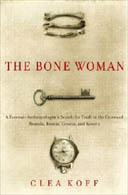
The Bone Woman
by Clea Koff
368pp, Atlantic Books, £12.99
In 1991, at the height of the war in Croatia, the town of Vukovar fell to Serbian forces after a protracted and bloody siege. In the aftermath, more than 200 male patients and staff from the hospital were loaded at gunpoint into Yugoslav army trucks. One person managed to escape as the vehicles were being driven along a dirt track leading to an agricultural rubbish dump. The whereabouts of the rest of the prisoners remained unknown.
Clea Koff was among a team of forensic scientists sent by the United Nations international criminal tribunal for the former Yugoslavia to investigate the dump in 1996. Serbian authorities had consistently denied harming the prisoners. Relatives of the missing, the "Mothers of Vukovar", remained strident in their belief that their loved ones were still alive. Koff recounts the backbreaking excavation and "cleaning" of the site, gradually exposing hundreds of corpses in a tangled heap. Drip-tubes, plaster casts, operating clogs and X-rays were exhumed with them. "Finding the bodies in the pit and then observing the subsequent accumulation of medical material was like watching several raindrops on a window merge into one large droplet, whose weight drags it down the glass, leaving a trail you can trace with your finger." Five years after they disappeared, the Vukovar hospital prisoners' fate was established.
The Bone Woman offers a fascinating insight into the role of forensic anthropology in investigating human rights abuses. Koff worked at sites of several of the most notorious atrocities of recent years, both in the former Yugoslavia and in Rwanda. Her account revivifies events that have begun to desiccate in the dry air of history - the notches found on ankle bones in Rwanda caused by machete blows that severed victims' Achilles tendons, immobilising them until their attackers, wading through a sea of potential targets, could find the time to kill them. The anthropologists' methodology sometimes seems gruesome - Koff describes a colleague manually tearing jaws off heads to access the dentition that helps estimate a victim's age - but the evidence they gathered has played a crucial role in the prosecutions of the alleged perpetrators.
During the four years Koff worked on UN missions, forensic anthropology burgeoned in importance. The small team she joined in 1996 was convened on an ad hoc basis and sent into the field with scant equipment. By 2000, investigations had become major logistical exercises. Koff, too, was very different from the 23-year-old postgraduate she had been at the outset.
Beyond its evidential value, identification has profound implications for the surviving family. Often these are positive, ending the anguish of uncertainty, as well as ensuring the return of a loved one's remains for a funeral. Yet the Mothers of Vukovar, who tried initially to halt the UN investigation of the rubbish dump site, illustrate the anthropologist's power to dash hope. Koff's attempts to resolve this "double vision" endow The Bone Woman with an engrossing thematic complexity.
Koff's memoir is based on journals she kept while on her six missions, and she devotes disproportionate space to the niggles and personality spats that occurred with other UN personnel. These were undoubtedly important to her at the time, but for the reader they merely establish that a forensic investigation team is subject to the same "office politics" as everyone else. On occasion, Koff strays into conjecture as to the motives behind the war crimes and genocide she helped to investigate. Her conclusion - that historical, cultural and religious differences are just camouflage for political and economic self-interest - hardly seems groundbreaking.
These disappointments are perhaps a reflection of Koff's relative youth; she has only just turned 30, and it is sobering to consider the extremity of the experiences she has already assimilated. The overriding impression is of a woman deeply committed to ideals of justice and human rights. In consequence, and despite the extraordinary depravity of the crimes detailed in its pages, The Bone Woman is a humane, hopeful and involving book.
· Phil Whitaker is a GP, novelist and former forensic medical examiner

